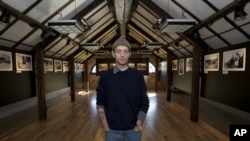Twenty-five years of war around the world are on display at a new exhibit in Washington, DC, called the "War Zone." It's a collection of still photographs by Italian photojournalist Enrico Dagnino - powerful images that shine a spotlight on the cruelty of war. Dagnino has covered all the recent conflicts in Eastern Europe, the Middle East, Africa and Asia. His pictures tell stories which echo the thoughts of other journalists who also were there. And they tell a tale of war and survival.
Born in Italy and based in Paris, photographer Enrico Dagnino has gone to the heart of conflicts around the world: Bosnia, Croatia, Chechnya, Kosovo, Afghanistan, Rwanda, Kenya, Somalia. He has been arrested, beaten and threatened many times while covering wars. We reached him in Kenya, before his next assignment in Sudan.
"The moment I take the picture is like I am almost not there. It slowly starts coming later and growing inside you," he says.
Please be advised that some of the images are extremely graphic in nature and may not be suitable for all viewers.
The stories of war are also the stories of survival. One of the most cruel conflicts in recent history was the one in Chechnya in the mid-1990s, which unofficially claimed about 300,000 lives. Many people are still missing, including the husband of journalist Fatima Tlisova. Tlisova herself was arrested seven times, and even poisoned, because of her reporting.
"When you report from the war, you see human flesh everywhere," she says. "In the winter it is corpses half eaten by dogs on the streets, in the summer it is mostly the smell. It is penetrating your lungs."
More than 100,000 people were killed in the war in Bosnia between 1992-1995. 2.2 million people were displaced and over a million ended up as refugees. Sixteen-hundred children alone were killed during the siege of the capital, Sarajevo.
"One had to have enough strength and courage to go out in the street and not look around, because there was not a single day that I did not see a dead body around me," says Mladen Bosnjak, who covered the seige for Radio Sarajevo.
Enrico Dagnino was there too. He says the brutality of one Serbian paramilitary leader, Zeljko Raznatovic, was almost too much for him to handle.
"At the beginning of the Sarajevo siege I saw a soldier running on a bridge," he says. "That was the only moment when I was a little bit scared to press the shutter. But I did press it, and they arrested me, confiscated the film, beat me."
Dagnino says the images of war he most vividly remembers are from Bosnia - and from the wars he covered in Africa.
Fierce fighting in Democratic Republic of Congo in 2000 was the widest multi-national war in modern African history. Paul Ndiho was another journalist who took great personal risks there.
"I have never been in a situation where I had seen so many people killed in one night," he says. "People were massacred in large number, especially women and children. I saw several mass graves, people who were buried, fresh bodies being taken out of their houses."
French photographer Jean Louis Atlan is the owner of the Zone 2.8 gallery, which is hosting the “War Zone” exhibit. He also covered events in Afghanistan, Iran, Poland and the Middle East -- and covered the White House for 10 years as well.
"You do not see those pictures in magazines," he says. "You see them maybe once from time to time. The difficulty of taking a photograph is to try to get in one photograph the whole story."
Enrico Dagnino says his images can be seen as question marks for human behavior. He says that he does not trust humanity as he did before. Other journalists feel the same way. Fatima Tlisova says that “it can’t be true, but it is.” And Paul Nidho adds that he is haunted by the voices of conflicts he covered, and that he sometimes hears them in his dreams.
But Dagnino says he has no regrets. Given the option, he would do it all over.
"In my next life I will be a photojournalist again…. For sure…," he says.
Photo Exhibit Shows Grim Face of War






